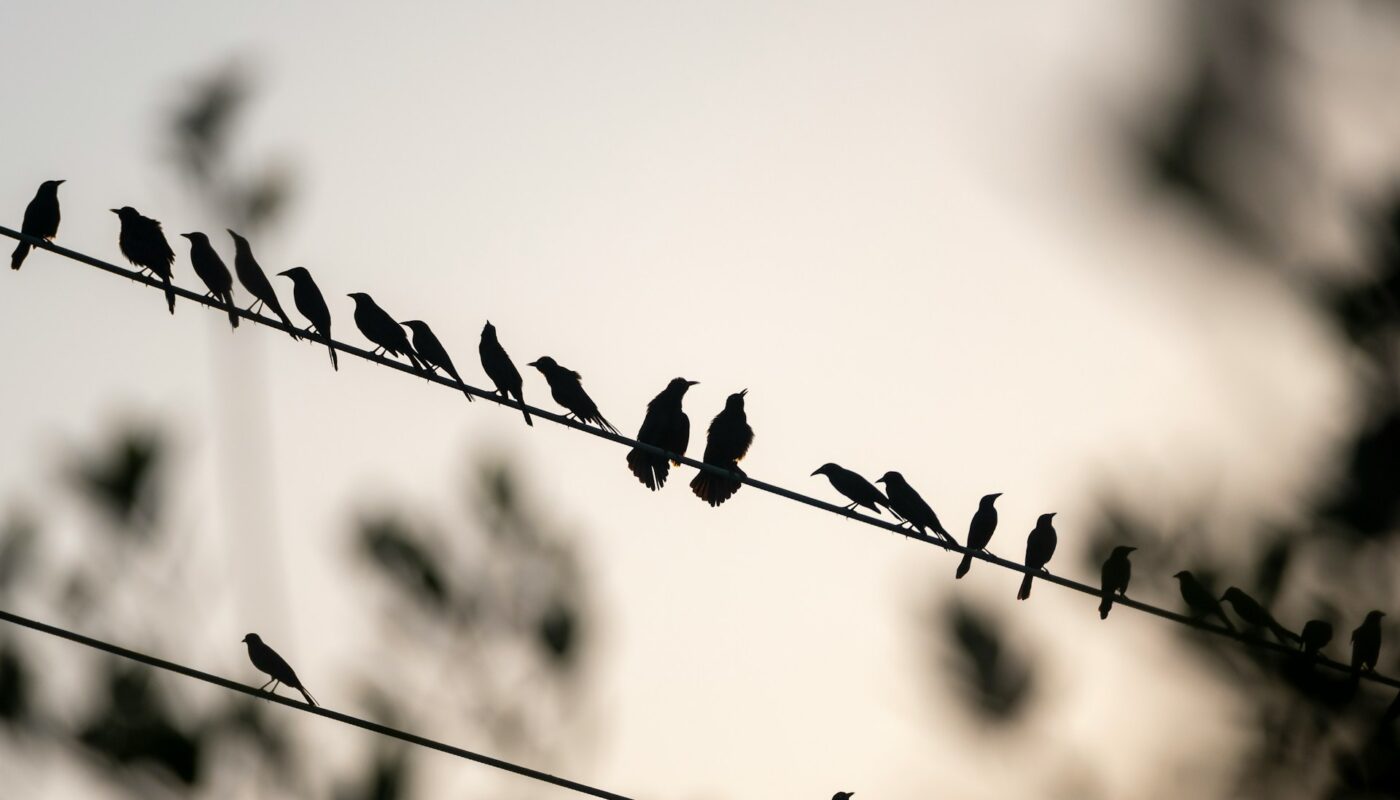Birdwatching is a popular pastime in Michigan, thanks to the state’s diverse habitats and the wide variety of bird species that call it home. Small birds often capture the most attention among these avian wonders with their vibrant colors, melodic songs, and fluttering movements. Whether you’re a seasoned birdwatcher or just beginning to explore the birding world, identifying small birds in Michigan can be both a challenging and rewarding experience.
Small birds play a crucial role in Michigan’s ecosystems, from controlling insect populations to aiding in seed dispersal. This guide will help you identify some of Michigan’s most common small birds, including tips on spotting the tiniest and often most elusive species. We’ll cover the differences between the smallest birds in Michigan, how to distinguish small brown birds from other species, and where you can find these delightful creatures throughout the year.
Lets Talk About Small Birds In Michigan
Identifying Small Birds of Michigan
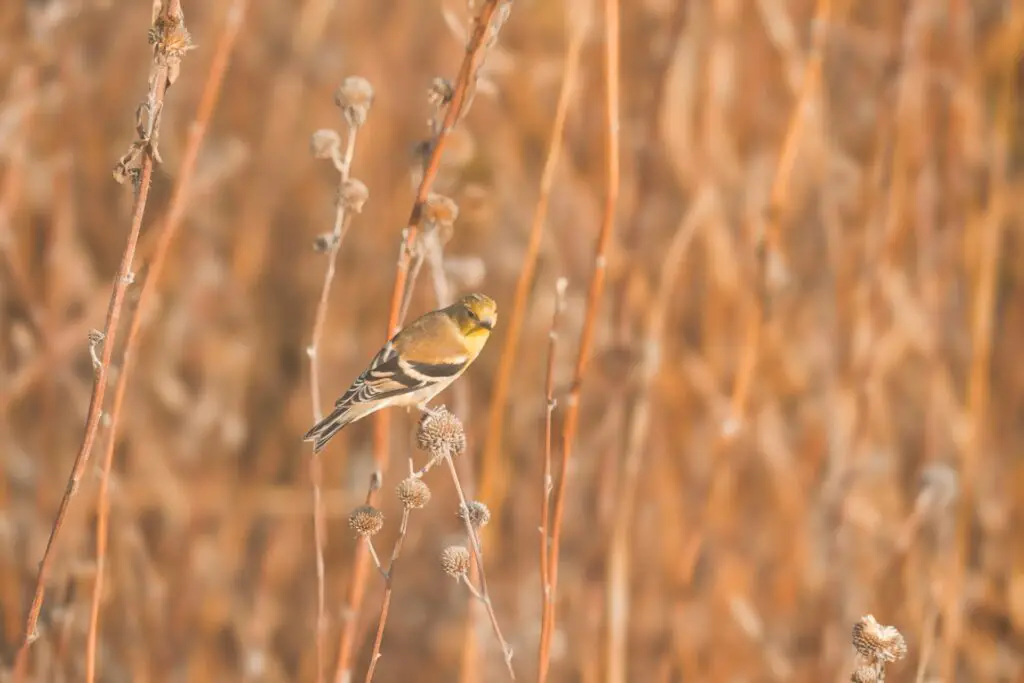
Identifying birds in Michigan, especially the small and agile ones, can be a delightful challenge. Small birds are generally defined as those that measure under 8 inches long, though many are much smaller. To spot these tiny birds in Michigan, focusing on key features like size, plumage color, song, and behavior is helpful.
One of the most critical aspects of identifying small birds in Michigan is observing their movement and feeding habits. For example, the Black-capped Chickadee, a common resident, is often seen flitting between tree branches and hanging upside down while searching for insects. In contrast, the American Goldfinch, another small bird commonly found year-round, is known for its acrobatic flights and distinctive call.
Small brown birds in Michigan, such as sparrows and wrens, can pose a unique identification challenge due to their often subtle differences in color and markings. To distinguish between species, look closely at features like the shape of the tail, wing bars, and even their songs. Understanding these characteristics will make identifying birds easier and deepen your appreciation for the diversity of small birds in Michigan.
Common Small Birds in Michigan
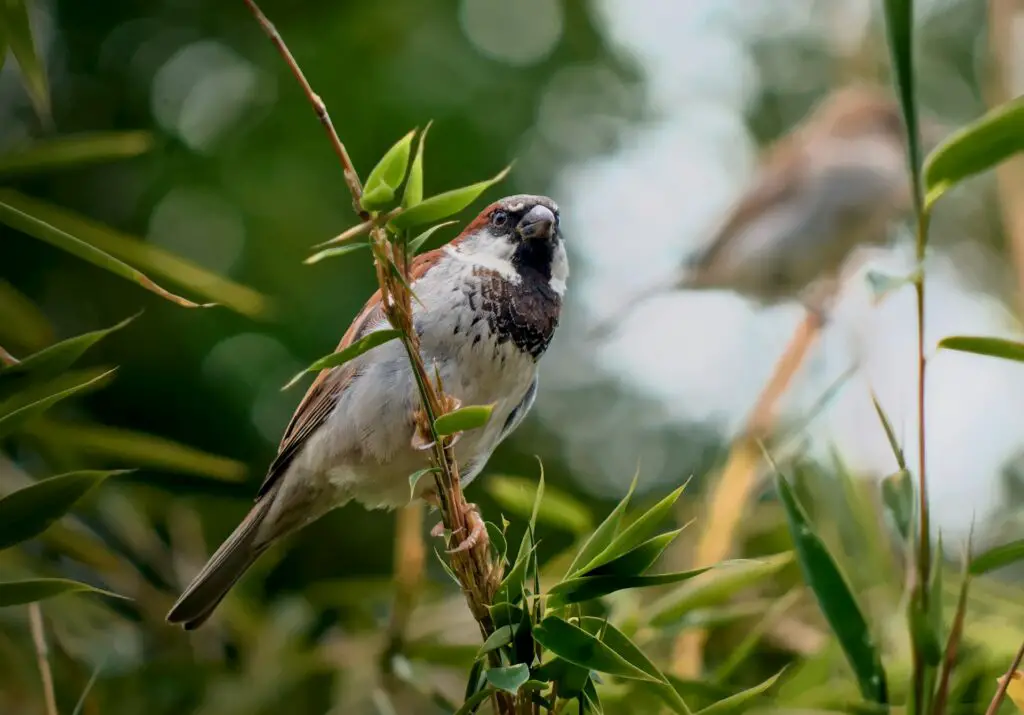
Year-Round Small Birds
Michigan is home to various small bird species that can be seen throughout the year. These birds have adapted well to the state’s seasonal changes and can be found in a range of habitats from forests to suburban backyards.
Black-capped Chickadee
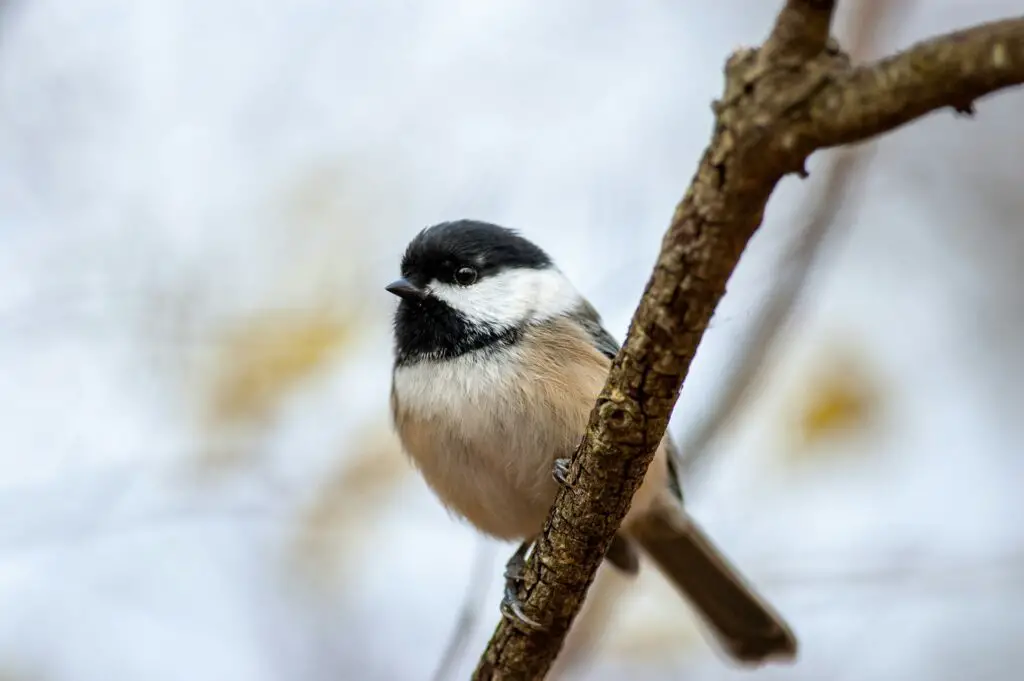
One of the most recognizable small birds in Michigan, the Black-capped Chickadee, measures about 5-6 inches in length. Its black cap and bib, white cheeks, and fluffy appearance easily identify it. Chickadees are curious and friendly birds that often travel in small flocks, especially during winter when they join other species in search of food. They are commonly seen at feeders, where they enjoy sunflower seeds, suet, and peanuts.
American Goldfinch
The American Goldfinch is another year-round resident and one of the most common small birds in Michigan. Known for their bright yellow plumage in summer and a more subdued olive-brown in winter, these birds are about 5 inches long. Goldfinches are often spotted in open areas, including gardens and fields, where they feed on seeds from flowers like sunflowers and thistles. Their distinctive flight pattern and cheerful call make them easy to identify.
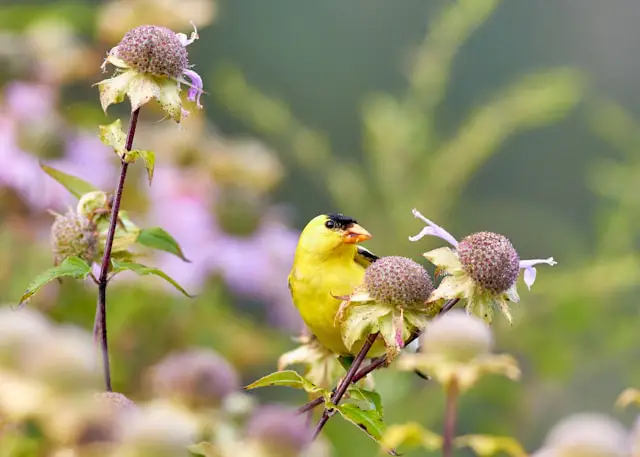
Downy Woodpecker
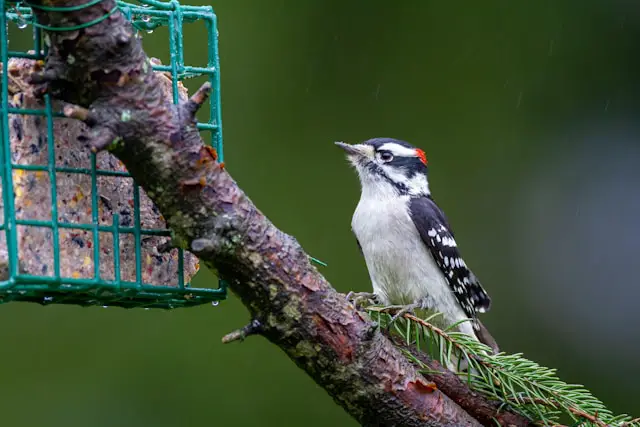
The Downy Woodpecker, though often associated with woodlands, is a frequent visitor to backyard feeders, especially in winter. As the smallest woodpecker in North America, measuring about 6-7 inches, it is easily identified by its black and white plumage and the male’s red nape patch. Downy Woodpeckers can be distinguished from similar Hairy Woodpecker by their smaller size and shorter bill.
Migratory Small Birds
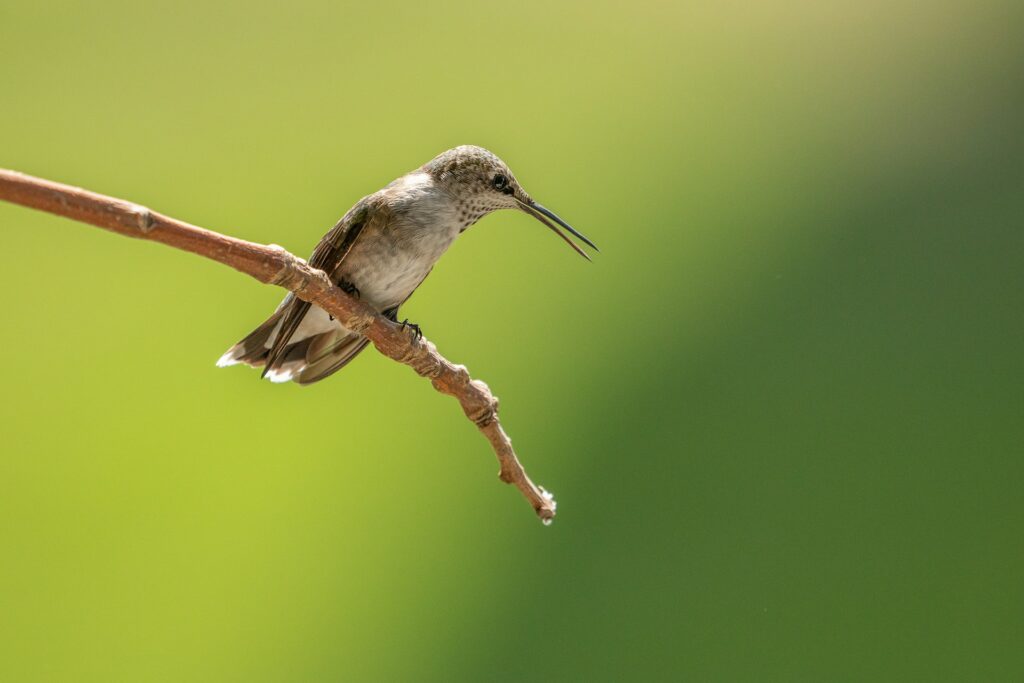
Michigan’s location along major migratory routes means that a variety of small birds pass through the state seasonally. These migratory species often add a splash of color and excitement to spring and fall birdwatching.
Ruby-crowned Kinglet

One of the smallest migratory birds in Michigan, the Ruby-crowned Kinglet measures about 4 inches long. It is easily identified by its constant wing-flicking behavior and, in males, a small, red crown patch that can be seen when the bird is excited. These tiny birds are typically found in forests and woodlands during migration and are known for their energetic movements and complex songs.
Yellow Warbler
The Yellow Warbler is a small, bright yellow bird that migrates through Michigan in the spring and summer. About 5 inches in length, it is often spotted near water, such as along streams and in wetlands. Yellow Warblers are one of the easier warblers to identify, thanks to their overall yellow color and sweet, whistled song.
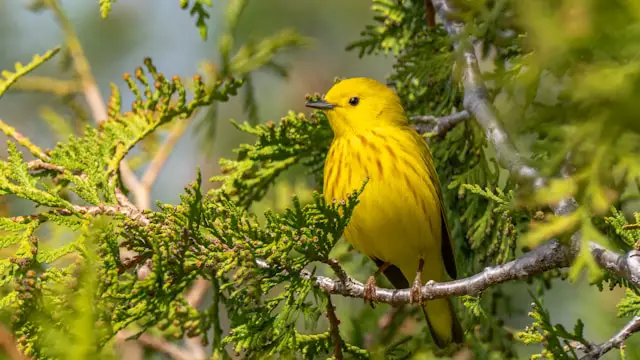
Ruby-throated Hummingbird
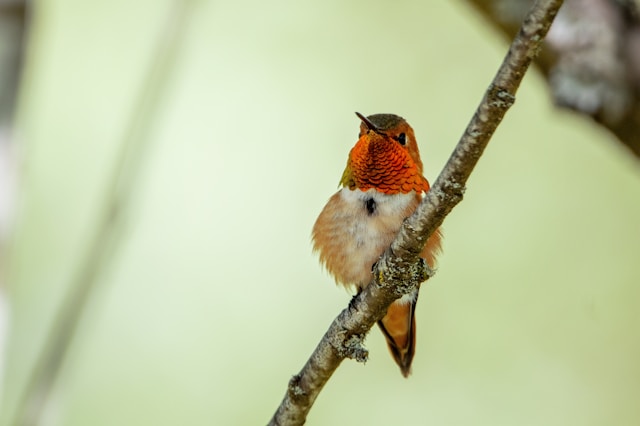
The Ruby-throated Hummingbird is Michigan’s only breeding hummingbird and one of the smallest birds in the state, measuring just 3-3.5 inches. Males are easily identified by their iridescent red throats, while females are plain with green backs and white underparts. These tiny birds are often seen hovering near flowers and feeders, especially during their late spring and early fall migration.
Small Brown Birds in Michigan

Identifying small brown birds in Michigan can be tricky due to their often similar, subtle plumage and behavior. However, these little brown birds, often referred to as “LBJs” (Little Brown Jobs) in birdwatching circles, add an exciting challenge for bird enthusiasts.
House Sparrow
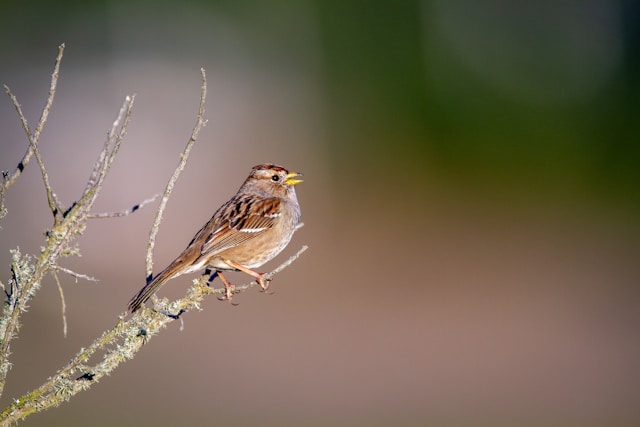
One of the most familiar small brown birds in Michigan is the House Sparrow. About 6 inches long, this species is easily spotted in urban areas, parks, and backyards. Males have distinctive black bibs, white cheeks, and chestnut necks, while females and young birds are more uniformly brown with lighter streaks on their backs. House Sparrows are highly social and are often seen in noisy flocks, feeding on seeds and scraps.
Song Sparrow
The Song Sparrow is a common, small brown bird found throughout Michigan’s fields, gardens, and wetlands. Measuring about 5-7 inches in length, it is identified by its heavily streaked breast with a central dark spot and a rounded tail. Song Sparrows are known for their cheerful and varied song, which can be heard year-round. Their adaptability to different habitats makes them one of the most widespread sparrows in the state.
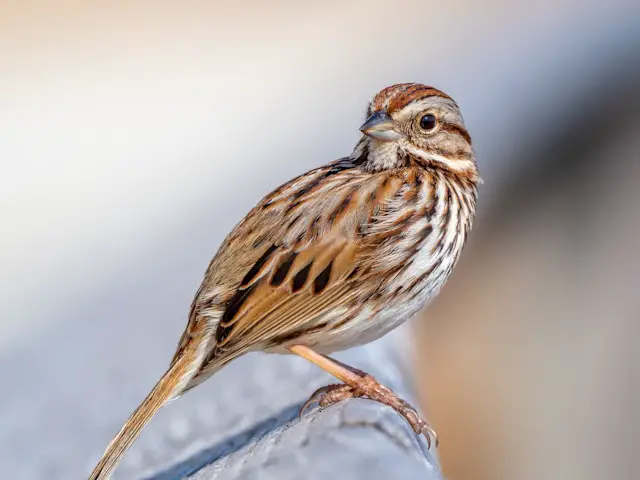
Brown Creeper
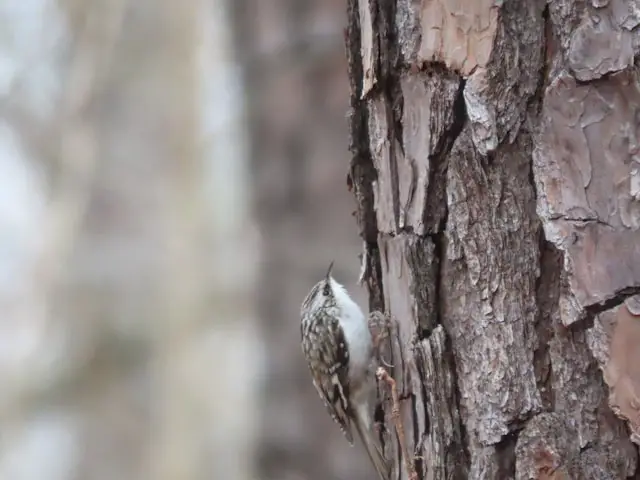
The Brown Creeper is a tiny bird, about 5 inches long, that blends in perfectly with the bark of trees. It has a mottled brown and white plumage that makes it look like part of the tree trunk as it spirals upwards in search of insects. Brown Creepers are less common than sparrows but can be found in wooded areas, especially in older forests with plenty of large trees. Their distinctive behavior of creeping up tree trunks sets them apart from other small brown birds in Michigan.
By paying attention to unique characteristics such as tail shape, plumage pattern, and feeding behavior, identifying small brown birds in Michigan becomes an achievable task even for beginner birdwatchers.
Where to Spot Small Birds in Michigan
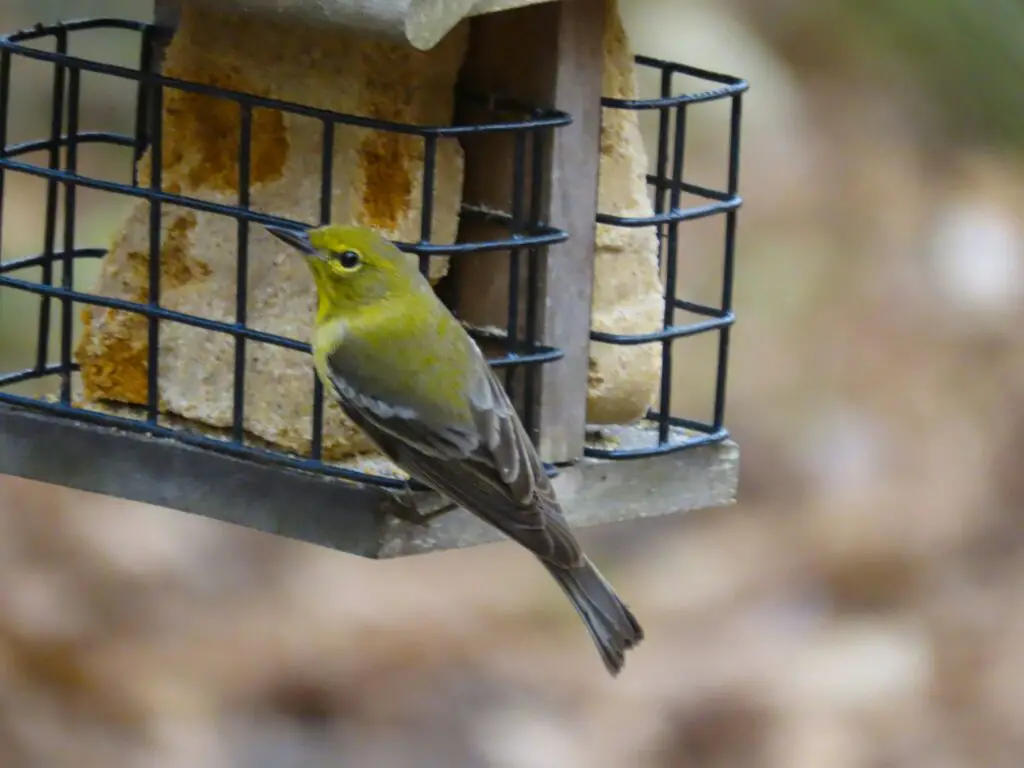
Michigan’s diverse landscapes offer numerous opportunities for spotting small birds, whether you’re in a dense forest, a bustling city park, or even your own backyard. Understanding the preferred habitats of these birds can significantly enhance your birdwatching experience.
Forests and Woodlands
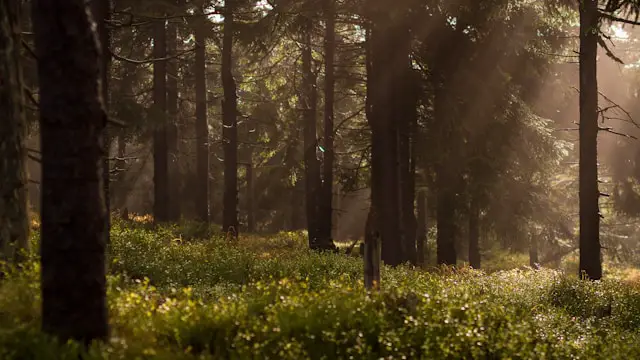
Forests and woodlands are prime habitats for many small birds of Michigan, such as chickadees, nuthatches, and warblers. Look for these tiny birds high in the canopy or flitting between shrubs and undergrowth. Some popular forested areas for birdwatching include the Huron-Manistee National Forests, Sleeping Bear Dunes National Lakeshore, and Porcupine Mountains Wilderness State Park.
Wetlands and Waterways
Wetlands, marshes, and areas near water bodies attract a variety of small birds, including sparrows, wrens, and warblers. The presence of water provides ample food and shelter for these species, making these spots ideal for birdwatching. Notable locations include Shiawassee National Wildlife Refuge, Kensington Metropark, AuSable Basin near Oscoda, and Seney National Wildlife Refuge.
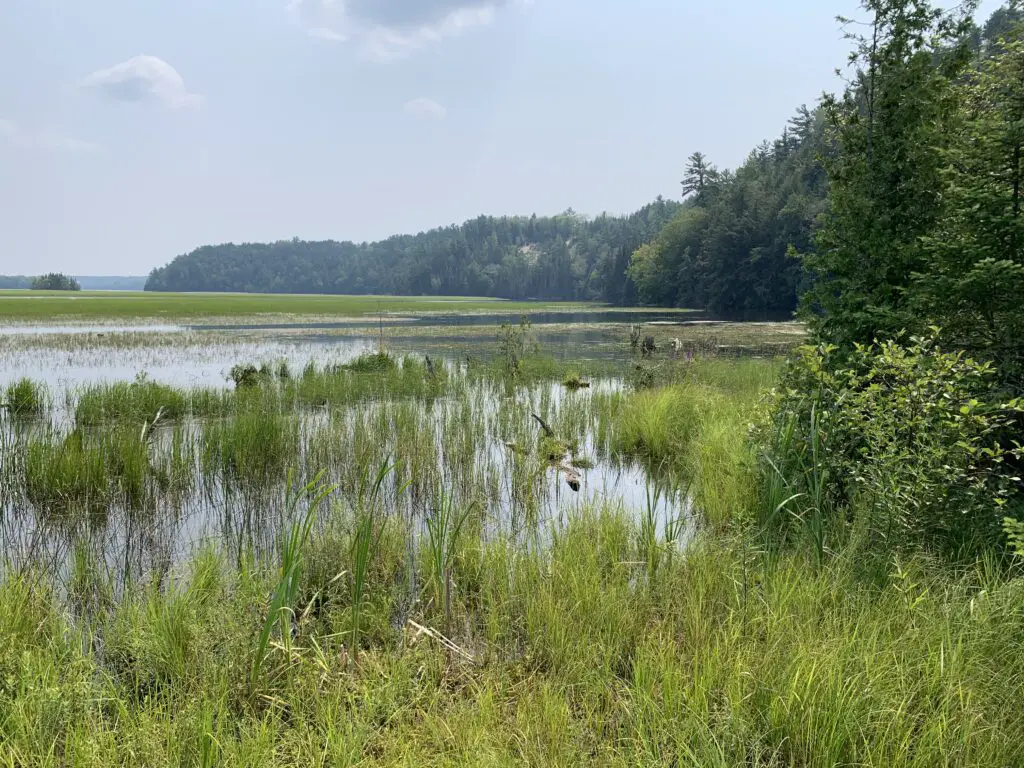
Urban and Suburban Areas

Even in urban and suburban settings, Michigan’s small birds thrive. Backyards, parks, and gardens can be great places to observe birds like House Sparrows, American Goldfinches, and Downy Woodpeckers. Setting up bird feeders with seeds, suet, and nectar can attract a wide variety of small birds to your space. The Detroit River International Wildlife Refuge is an excellent urban birdwatching spot that attracts both local and migratory species.
Creating a Bird-Friendly Backyard
One of the most rewarding ways to enjoy birdwatching is by attracting small birds to your own backyard. Providing food, water, and shelter can draw in many of Michigan’s tiny birds. Install feeders stocked with a variety of seeds, nuts, and suet, and plant native shrubs and flowers to provide natural food sources and cover. Additionally, birdbaths or small water features can attract species like finches and warblers, especially during migration.
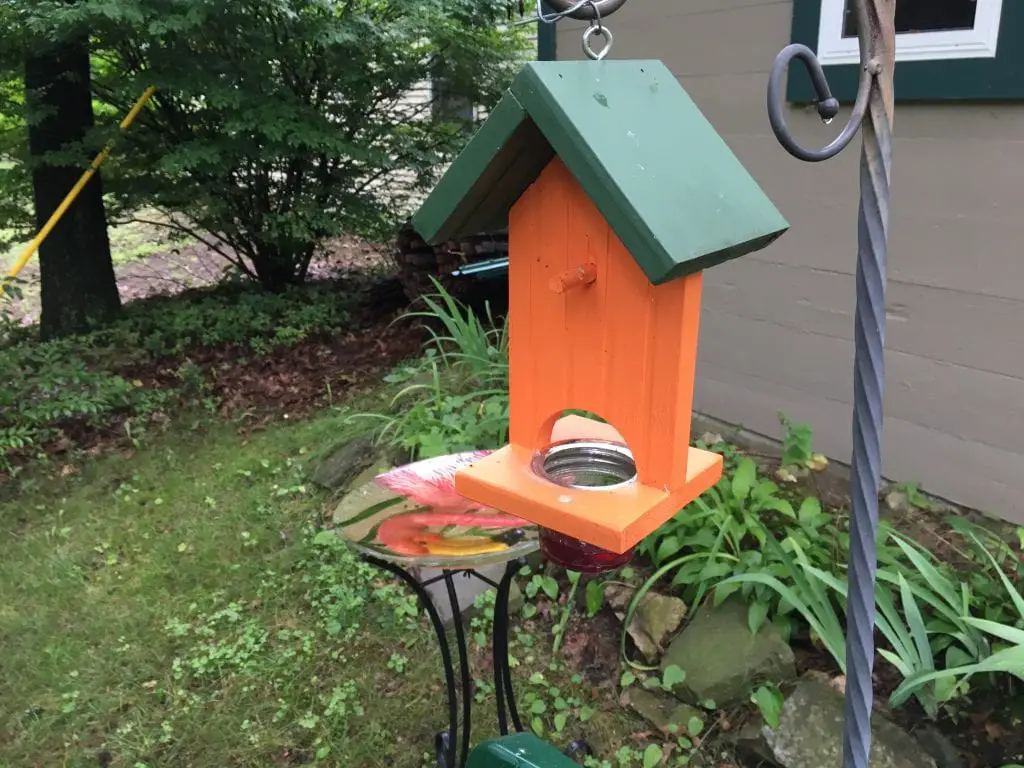
By exploring these habitats and understanding where small birds are most likely to be found, birdwatchers can maximize their chances of spotting a wide range of small bird species in Michigan.
Top 10 Birdwatching Areas In Michigan
Here’s a table with the top ten birdwatching areas in Michigan, including their names, locations, and what each area is known for:
| Name | Location | What the Birdwatching Area is Known For |
|---|---|---|
| Shiawassee National Wildlife Refuge | Saginaw, MI | Known for wetland habitats and large flocks of waterfowl and migratory birds. |
| Tawas Point State Park | East Tawas, MI | Famous for spring migration, especially warblers and shorebirds. |
| Whitefish Point Bird Observatory | Paradise, MI | Renowned for raptor and owl migrations, especially in spring and fall. |
| Kensington Metropark | Milford, MI | It is famous for warbler migration and is considered one of the best birding spots in North America. |
| Pointe Mouillee State Game Area | Rockwood, MI | Known for shorebirds, waterfowl, and one of the largest freshwater marshes in the U.S. |
| Sleeping Bear Dunes National Lakeshore | Empire, MI | Features varied habitats with opportunities to see songbirds and raptors. |
| Seney National Wildlife Refuge | Seney, MI | Known for a mix of wetlands, forests, and grasslands attracting a variety of bird species, including Trumpeter Swans. |
| Hartwick Pines State Park | Grayling, MI | Notable for old-growth pine forests and sightings of crossbills and warblers. |
| Magee Marsh Wildlife Area | Oak Harbor, OH (near Michigan border) | Known for diverse habitats, including dunes, forests, and shorelines attracting migratory birds. |
| Saugatuck Dunes State Park | Holland, MI | Known for diverse habitats including dunes, forest, and shoreline attracting migratory birds. |
These birdwatching areas are some of the top spots in Michigan, offering diverse habitats and a wide variety of bird species, making them excellent for birdwatchers of all levels.
Identifying Birds in Michigan – Birdwatching Tips for Beginners

Birdwatching can be a delightful and fulfilling hobby, especially in Michigan, where diverse habitats support a rich array of small bird species. Whether you’re trying to identify small birds of Michigan or spot the tiniest ones, a few essential tips can enhance your birdwatching experience.
Essential Birdwatching Gear
To start identifying birds in Michigan, it’s helpful to have a few key items:
- Binoculars: A good pair of binoculars is crucial for getting a closer look at birds without disturbing them. Choose a lightweight model with a magnification of 8x or 10x, which offers a good balance of power and field of view.
- Field Guide or App: A field guide specific to Michigan or the Midwest will help you quickly identify small birds, including the more elusive tiny birds in Michigan. Apps like Merlin Bird ID or eBird can also be incredibly useful, offering instant identification and allowing you to log your sightings.
- Notebook or Journal: Keeping a birdwatching journal can help track which species you’ve seen, their behaviors, and their habitats. This practice not only enhances your observation skills but also adds a personal element to your birdwatching journey.
Best Times for Birdwatching
Small birds in Michigan can be spotted year-round, but the best times to see them are early in the morning or late in the afternoon when they are most active. During migration seasons—spring and fall—many species, including warblers and hummingbirds, pass through Michigan, offering prime opportunities for birdwatching. Winter months also provide unique birdwatching experiences, as many northern species visit Michigan, and local birds are more visible against the bare trees.
Birdwatching Etiquette and Conservation Tips
Respect for wildlife and nature is fundamental to birdwatching. Always keep a respectful distance from birds, especially during nesting season, to avoid causing stress or disturbance. Stick to designated paths in parks and nature reserves, and avoid playing bird calls on repeat, which can disrupt the birds’ natural behaviors.
Supporting conservation efforts is another vital part of birdwatching. Participating in citizen science projects like the Great Backyard Bird Count or contributing to local conservation groups helps protect the habitats of small birds in Michigan. Additionally, reducing the use of pesticides and keeping cats indoors can make a significant positive impact on bird populations.
Conservation and Protection of Small Birds in Michigan
Small birds in Michigan face various threats, including habitat loss, climate change, and pollution. Understanding these challenges and supporting conservation efforts are crucial steps in ensuring that these birds continue to thrive.
Threats to Small Birds in Michigan
Habitat loss is one of the most significant threats to small birds, as urban development and agricultural expansion reduce the available natural areas. Wetlands, forests, and grasslands—all critical habitats for birds—are particularly at risk. Additionally, climate change affects migration patterns, breeding seasons, and food availability, which can disrupt the life cycles of small birds, including some of the smallest birds in Michigan.
Pollution, particularly from pesticides, poses another serious threat. Chemicals used in agriculture and gardening can kill the insects that many small birds rely on for food, while also directly harming the birds themselves. Window collisions and predation by domestic cats are other common hazards that result in millions of bird deaths each year.
Conservation Efforts and How to Help
Numerous organizations and initiatives are dedicated to protecting small birds in Michigan. Groups like the Michigan Audubon Society and the Michigan Department of Natural Resources work on habitat restoration, education, and advocacy to support bird populations. Local nature reserves and wildlife refuges also play a critical role in preserving essential habitats.
As an individual, there are many ways you can contribute to the conservation of Michigan’s small birds:
- Create Bird-Friendly Spaces: Plant native species in your garden to provide food and shelter for birds. Avoid using pesticides, and consider installing birdhouses or nesting boxes to support breeding birds.
- Support Conservation Organizations: Donate to or volunteer with local bird conservation groups. Participation in bird counts or monitoring programs can also contribute valuable data to conservation efforts.
- Practice Responsible Birdwatching: Follow ethical birdwatching guidelines, such as keeping a safe distance and not disturbing birds in their natural habitats. Simple actions, like keeping your cat indoors and making windows bird-safe, can reduce the risk to birds in your area.
By taking these steps and staying informed about the challenges small birds face, you can help protect the vibrant avian life that makes Michigan a special place for birdwatching.
Final Thoughts About Small Birds In Michigan
Michigan is a haven for birdwatchers, offering a remarkable variety of small birds that bring color, song, and life to the state’s diverse landscapes. From the familiar year-round residents like the Black-capped Chickadee and American Goldfinch to the migratory visitors such as the Ruby-crowned Kinglet and Yellow Warbler, each species adds to the richness of Michigan’s natural heritage.
Identifying small birds in Michigan can be a rewarding experience that deepens your connection to nature. By learning to recognize these tiny birds and understanding their habitats and behaviors, you can appreciate the intricate roles they play in the ecosystem. Birdwatching is not only a fun activity but also a way to support conservation efforts by raising awareness and contributing to citizen science projects.
Whether you’re exploring a dense forest, strolling through a city park, or enjoying the view from your backyard, there are endless opportunities to observe and admire the smallest birds in Michigan. Embrace the challenge of identifying these little wonders and take action to protect them, ensuring that future generations can enjoy the vibrant birdlife that makes Michigan special.
Additional Resources
For those interested in diving deeper into birdwatching and conservation, here are some valuable resources:
- Field Guides and Apps:
- National Geographic Field Guide to the Birds of North America – A comprehensive guide for identifying birds across the continent.
- Merlin Bird ID by Cornell Lab – An app that helps with instant bird identification through photos and sounds.
- eBird – A global birdwatching app that allows you to track your sightings and explore bird populations in real-time.
- Birdwatching Clubs and Organizations:
- Michigan Audubon Society – Offers resources, events, and conservation programs to support birdwatching and protection efforts in Michigan.
- Detroit Audubon – Provides birdwatching events, educational programs, and advocacy for bird conservation in urban areas.
- Grand Traverse Audubon Club – Focuses on birdwatching activities and conservation in Northern Michigan.
- Birding Locations:
- Shiawassee National Wildlife Refuge – A premier spot for viewing migratory birds and a variety of small bird species.
- Kensington Metropark – Known for its diverse habitats and year-round birdwatching opportunities.
- Sleeping Bear Dunes National Lakeshore – Offers beautiful landscapes and a wide range of bird species, including many small birds.
- Conservation Initiatives:
- Michigan Bird Conservation Initiative (MiBCI) – A partnership of organizations dedicated to the conservation of birds and their habitats in Michigan.
- Great Lakes Marsh Monitoring Program – Involves volunteers in monitoring bird populations in the Great Lakes region’s wetlands.
These resources will help you expand your birdwatching skills, connect with local communities, and contribute to the preservation of small birds in Michigan. Happy birdwatching!
